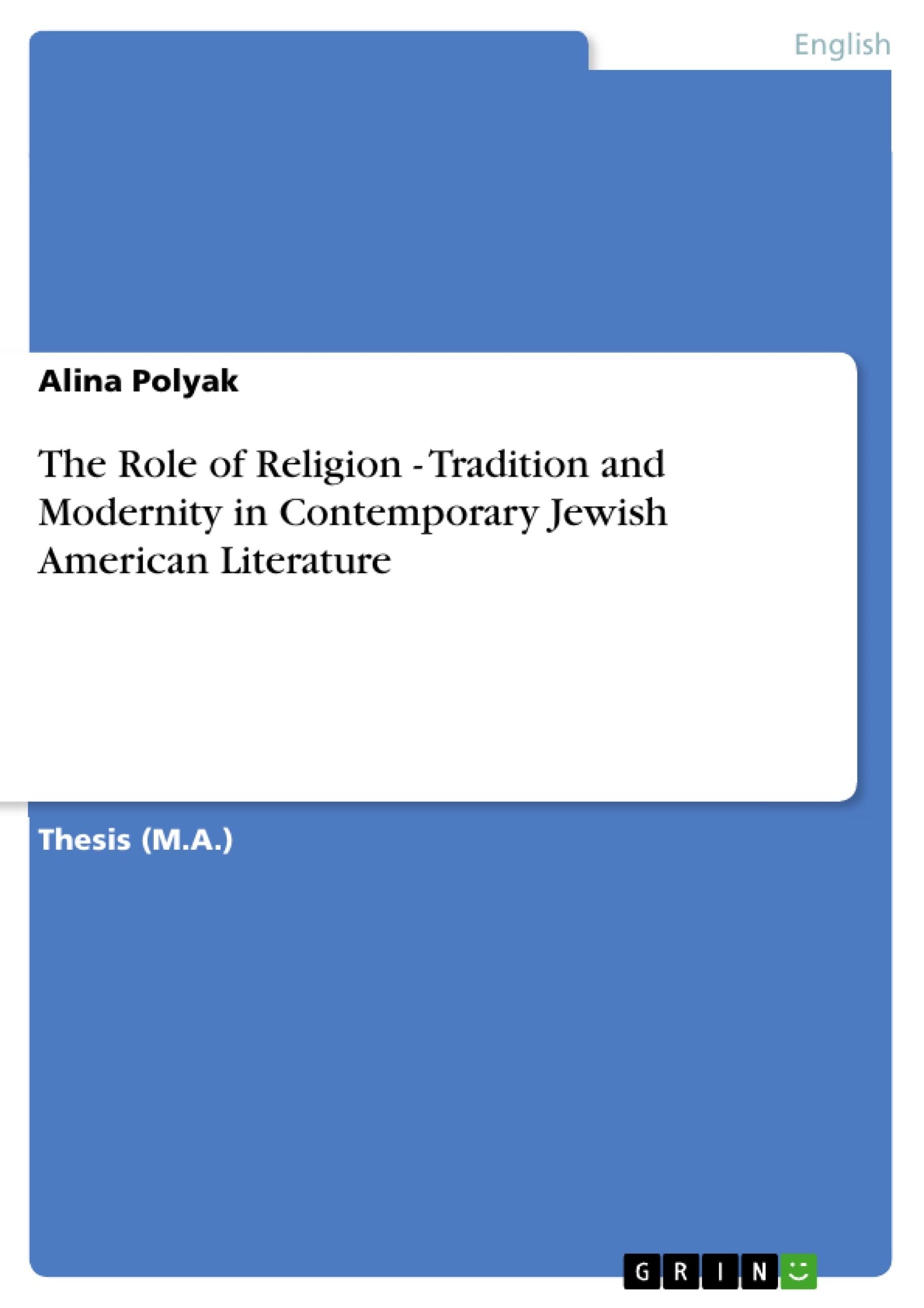In der Magisterarbeit handelt es sich um die Rolle der Religion in der modernen jüdisch-amerikanischen Literatur. Die Suche nach den Wurzeln ist ein Trend in der amerikanischen Gesellschaft geworden. Dieser Trend widerspiegelt sich auch in Kunst und Literatur.
Die Gesellschaft wandelt sich von einem “Schmelztiegel” in eine multiethnische und multikulturelle Gesellschaft. Viele Autoren wenden sich in ihren Werken an die Kultur ihrer Vorfahren. Die jüdisch-amerikanische Literatur ist auch ein Beispiel hierfür. Es ist fast unmöglich, die Kultur von der Religion zu trennen, denn wenn es sich um jüdische Themen handelt, geht es um die Kultur, die eng mit der jüdischen Religion verbunden ist.
Judentum ist eine Religion, die mit Zeit und Geschichte eng verbunden ist. Selbst wenn Autoren sich mit säkularen Themen beschäftigen, gibt es trotzdem eine Anbindung an die religiöse Problematik. Viele moderne Werke sind von Autoren geschrieben, die fundiertes Wissen vom Judentum haben, sie benutzen oft jüdische Sprachen, Figuren aus der Folklore und religiöse Ideen.
Es gibt einen großen Unterschied zwischen den frühen Werken von Immigranten und den modernen Werken der amerikanisch-jüdischen Autoren der dritten Generation. Während die Immigrantenautoren sich bemüht haben, sich so schnell wie möglich zu assimilieren und die Welt der Väter hinter sich zu lassen, haben die jüngsten Autoren in ihren Werken die jüdischen Themen neu entdeckt.
Für die Autoren der ersten Generation war das Erlernen der englischen Sprache sehr wichtig.
Die Autoren von heute haben Englisch als Muttersprache. Sie schreiben zwar auf Englisch, benutzen aber sehr häufig Begriffe oder Ausdrücke, die nicht erklärt oder übersetzt sind aus den jüdischen Sprachen Hebräisch und Jiddisch. Jüdische Literatur war immer multilingual.
Hebräisch ist die Sprache der Liturgie und Jiddisch ist die Sprache des Europäischen Judentums. Nach dem Holocaust wurden die meisten Sprecher des Jiddischen ausgerottet. Das ist der Grund, warum Jiddisch heute eine Rolle der “heiligen Sprache” spielt und in dieser Hinsicht an die Stelle des Hebräischen rückt. Das moderne Hebräisch ist die Staatssprache Israels und hat die Position der Alltagssprache genommen.
Table of Contents
- Introduction
- Historical overview
- Christianity as a "default" religion
- Conversion to Judaism
- Substitutes for religion
- Antisemitism
- Religious sources
- Folklore and mysticism: Golem and reincarnation
- Place
- The Lower East Side
- Israel
- Europe
- Ukraine
- Germany
- Language
- Hebrew
- Yiddish
- English
- Name and Identity
- Jewish tradition and feminism in women's writing
- Food and ritual
- Conclusion
Objectives and Key Themes
This work explores the role of religion, specifically Judaism, in contemporary Jewish American literature. It examines how Jewish identity is constructed and reinterpreted within the context of American society and culture, particularly in relation to traditional religious practices and modern cultural trends. The work highlights the influence of Jewish tradition on contemporary Jewish American writers and their literary output.
- The evolving Jewish identity in the United States
- The role of religious and cultural influences in shaping Jewish American literature
- The interplay of tradition and modernity in Jewish American writing
- The representation of Jewish folklore, mysticism, and religious concepts in contemporary literature
- The impact of Jewish American writers on American culture and literature
Chapter Summaries
The introduction examines the historical context of Jewish American literature and the evolving nature of Jewish identity in the United States. It discusses the influence of Christian tradition and the growing trend of ethnic multicultural writing, particularly among Jewish American writers. The chapter also highlights the significance of religion as a defining aspect of Jewish identity.
The chapter "Religious sources" focuses on the role of Jewish folklore and mysticism, specifically the Golem and reincarnation, in shaping contemporary Jewish American literature. It explores how these concepts are used to explore themes of identity, tradition, and modernity.
The chapter "Place" explores the geographical and cultural significance of various locations for Jewish American writers and their narratives. It examines the Lower East Side, Israel, and Europe, including Ukraine and Germany, as settings that contribute to the understanding of Jewish American experiences and identity.
The chapter "Language" explores the interplay of different languages in Jewish American literature, including Hebrew, Yiddish, and English. It examines how these languages are used to express Jewish identity and the challenges of navigating cultural and linguistic differences in American society.
Keywords
Key terms and concepts explored in this work include Jewish American literature, Jewish identity, religion, tradition, modernity, folklore, mysticism, place, language, culture, ethnicity, assimilation, and the influence of Jewish writers on American literature.
- Citation du texte
- Alina Polyak (Auteur), 2009, The Role of Religion - Tradition and Modernity in Contemporary Jewish American Literature, Munich, GRIN Verlag, https://www.grin.com/document/132426



